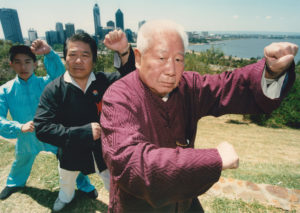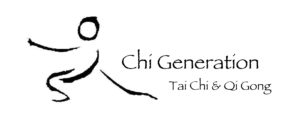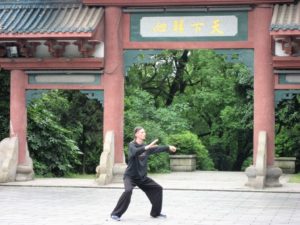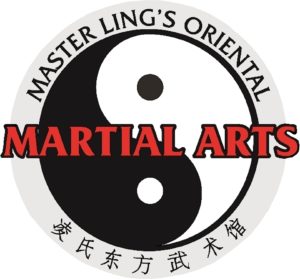Slanted FlyingJournal of Tai Chi Chuan
Training
The Eight Gates – Techniques Or Principles? An Attempt For An Explanation
The eight gates (bamen) are peng, lü, ji, an, cai, lie, zhou and kao. Dealing with them in theory and practice quickly brings up the following question:
Are they techniques to overcome an opponent, or are they general principles of movement?
These two views seem contradictory, but they can be blended to one, as the two sides of a coin. The eight gates are part of the thirteen basic movements (shisanshi) of Tai Chi Chuan. The Chinese word for basic movement shi has two main different meanings:
On the one hand, it has the meaning of (hand-) movement.
On the other hand, it has the meaning of strategic advantage, power or powerful position.
In merging these two meanings into one, the contradiction between principle of movement and technique can be resolved.
The eight gates as principles of movement
 If one understands the eight gates as a principle of movement, they tell you, how to deal with an evolving attack of the other. One uses the eight gates to understand the situation and the opponent (dongjin). By gently intervene in the situation one starts to develop a change to ones own benefit, but at the same time keeps all options open. The key is therefore to explore with minimal intervention. In practice this can, e.g., look like this:
If one understands the eight gates as a principle of movement, they tell you, how to deal with an evolving attack of the other. One uses the eight gates to understand the situation and the opponent (dongjin). By gently intervene in the situation one starts to develop a change to ones own benefit, but at the same time keeps all options open. The key is therefore to explore with minimal intervention. In practice this can, e.g., look like this:
Peng: I take a little of the force of the other and try to determine if I can absorb the full force.
Lü: I lead the force of the other a little bit into the emptiness and try to feel, if the other goes further on with his force, or if he retreats.
Ji: I press the other a little bit and try to feel if he collapses under the pressure, or if he pushes back.
An: I push a little into the emptiness of the other to determine whether he will collapse or if he is trying to change.
Cai: I pluck the other a little: does he stiffen up, or does he yield?
Lie: I’m trying to pull the other into a spiral: does it work or does the other block it?
Zhou: I come with my elbow from the side against the attacking power of the other. Is he trying to hold against it, or does he try to get away?
Kao: I lean toward the others’ centre of gravity or line of force. Does he resists or is he surprised?
In all cases, the eight gates are used to understand the force of the other (intensity, overall direction of the force, components of the forces, etc.) by feeling (tingjin). When I succeed, I have gained a strategic advantage. I now know beforehand, what the other intends to do and I can adjust my actions accordingly.














One thought on “The Eight Gates – Techniques Or Principles? An Attempt For An Explanation”